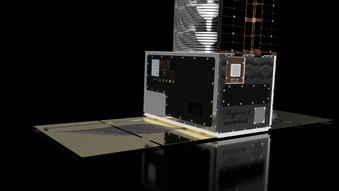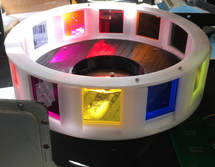Request for Proposals (December 2018)
In late 2020, SpaceFab will be launching the Waypoint 1 satellite, a 220mm diameter space telescope that will be available for astrophysics research. The satellite will be a multi purpose 12U cubesat, that will be serving 3 main markets, astronomy, ground observation and space situational awareness. We would like to grant some time for astrophysics research, at no charge, based on the merit of research proposals. SpaceFab will be accepting research proposals starting December 2018 and will award time by March 31, 2019. Proposals are due by February 28, 2019.
In late 2020, SpaceFab will be launching the Waypoint 1 satellite, a 220mm diameter space telescope that will be available for astrophysics research. The satellite will be a multi purpose 12U cubesat, that will be serving 3 main markets, astronomy, ground observation and space situational awareness. We would like to grant some time for astrophysics research, at no charge, based on the merit of research proposals. SpaceFab will be accepting research proposals starting December 2018 and will award time by March 31, 2019. Proposals are due by February 28, 2019.
The Waypoint 1 satellite is the first in a constellation of 16 satellites to be launched from 2020 on. This is a commercially funded space telescope system and will be available to anyone to use (as allowed by US law).* Outside of the grant program, astronomical observations will be offered at a very reasonable price.
The following will be awarded:
We encourage you to publish your research, once it is complete.
Under certain circumstances, the spacecraft’s hardware can be adjusted or modified for a great proposal. Suggestions are welcome. We would give credit to plans or ideas that help to characterize or improve the satellite.
International proposals will be accepted.*
See below for submission guidelines.
The following will be awarded:
- Best amateur astronomer proposal
- Amateur astronomer being defined as a person belonging to an astronomy club
- Example: John Jones belongs to the Rose City Astronomers and has a great idea for a research project.
- Amateur astronomer being defined as a person belonging to an astronomy club
- Best professional researcher proposal
- Any science educator or person being paid to conduct research.
- Example: Jane Smith works at the Gemini telescope and has a research project in mind.
- Example 2: Johny Jones works for Middleton high school, teaching physics and wants to conduct a research project with the help of his students.
- Any science educator or person being paid to conduct research.
- Best university student (in a physics/astronomy program) proposal
- Any full time university student enrolled as physics or astrophysics major. Grad students are also welcome to submit under this heading.
- Example: Xi Wong goes to Appalachian State University and wants to submit a research proposal.
- Any full time university student enrolled as physics or astrophysics major. Grad students are also welcome to submit under this heading.
- Best general public submission proposal
- This is open to anyone with an interest in astronomy
We encourage you to publish your research, once it is complete.
Under certain circumstances, the spacecraft’s hardware can be adjusted or modified for a great proposal. Suggestions are welcome. We would give credit to plans or ideas that help to characterize or improve the satellite.
International proposals will be accepted.*
See below for submission guidelines.
Waypoint spacecraft capabilities:
- Main mirror: 220mm silicon carbide substrate with protected enhanced aluminum coating.
- Optical Design: F/7.2 Modified Dall Kirkham
- Correction lenses: 3 radiation proof fused silica.
- Focal length will be 1600mm
- Imagers:
- 48 Mp CMOS main imager with .6 arcsecond resolution per 2x2 pixels.
- 8 Mp EMCCD with .7 arcsecond resolution and Lumagen coating for UV sensitivity down to 200nm, with 10% QE. 50% QE at 500nm. This chip will have a 20x gain.
- 2 Mp 150+ line hyperspectral imager with 10 nm wide bands from 470 to 900nm
INSTRUMENTS:
Modified Dall Kirkham Design
- Diameter - 220mm
- Focal Ratio - f/7.2
- Focal Length - 1598.5mm
- 48 Mp CMOS imager: 0.6 arcsecond resolution per pixel, 1 deg x 1.3 deg FOV,
- 8 Mp EMCCD: 0.7 arcsecond resolution, Lumagen coating, 20x gain, UV sensitivity to 200nm with 10% QE, 50% QE at 500nm
- 2 Mp 150 Band Hyper-Spectral imager: 10nm wide bands (470nm to 900nm), 1.4 arcsecond resolution
- Guiding: Each sensor will have an associated guide chip.
- XY stages: The 48 Mp and 8 Mp cameras will allow dithering and fine guiding (fractional pixel movement)
- Focuser: The secondary will have an XYZ stage for focusing and collimation.
- Reaction wheels: A set of 4 large wheels will be used for target acquisition, while a set of 4 small wheels will be used for target lock and stabilization.
FILTER SET:
FILTER |
BANDPASS |
NOTE |
luminance |
450 - 900nm |
Used with hyperspectral camera |
polarizer |
TBD - 900nm |
|
black |
black on titanium |
Sun Shield / Dark Frames |
H Alpha |
TBD |
|
H Beta |
TBD |
|
O-III |
TBD |
|
200-300nm & Sloan U |
Top half: 200 - 320nm Bottom half: 320 - 385nm |
|
Sloan G |
401 - 550nm |
|
NII & Sloan R |
Top half: TBD nm Bottom half: 562 - 695nm |
|
S II & Sloan I |
Top half: TBD Bottom half: 695 - 844nm |
|
Five stripe BGRi |
450 - 520 nm (B) 520 - 600 nm (G) 625 - 695 nm (R) 760 - 900 nm (I) 450 - 900 (clear) |
IKONOS/GeoEye compatible |
Grism |
TBD |
Proposal Submission Guidelines:
- Descriptive title
- 500 word abstract to be submitted with full proposal
- Introduction (Up to 3 pages)
- Tell us about yourself
- Introduce your project
- Project’s goals and desired outcome
- Broader impact? (As described by the NSF: “How well does the activity advance discovery and understanding while promoting teaching, training, and learning? How well does the proposed activity broaden the participation of underrepresented groups (e.g., gender, ethnicity, disability, geographic, etc.)? To what extent will it enhance the infrastructure for research and education, such as facilities, instrumentation, networks, and partnerships? Will the results be disseminated broadly to enhance scientific and technological understanding? What may be the benefits of the proposed activity to society? “ )
- Desired Outcomes and evaluation criteria (up to 1 page)
- What are you main research questions?
- How do you plan to evaluate whether you are succeeding?
- Background (2-3 pages)
- Related projects or work for your contributions
- Show relevant related papers and research (if any)
- Bibliography
- References and recommendations (if any)
- Proposed Research (6 pages)
- Please describe your research in detail
- Evaluation Plan (2-3 pages)
- Research schedule, amount of time needed. Will you require specific observation times or can your research be done whenever spacecraft time is available?
- List of objects to be studied and their coordinates, if applicable (RA, DEC)
- How will you extract the information from the data
- How do you plan to analyze the data?
- Explain how you will use the data to extract the science. Show time line of your observational needs precisely.
- Be very concrete about how you plan to run your evaluations. You aren't obliged to do exactly what you propose, but it's important to show that you've thought carefully about experiment design.
- Timeline table for Implementation and Evaluation (.5 pages)
- Include a table showing what you plan to do. Again, you don't need to follow this exact timeline, but it's important to come up with something feasible.
- Unfunded collaborators or evaluators? (.5 pages)
- If you will have advisory help, please list who, what capacity and their background.
- In the event that your project is not selected, would you have another means of getting funding? If so, by whom or what entity? For this proposal, assume $25 per minute for low priority observations and $50 per minute of high priority, scheduled, observations. The exact pricing is still TBD.
*Sorry, but we can not accept proposals from the following countries: Cuba, Iran, North Korea, Sudan, and Syria, as listed by the US Department of Commerce Export Administration Regulations (EAR). This proposal is strictly for looking at natural astronomical objects or phenomena.
All submissions should be in PDF format and sent to info@spacefab.us,
or mailed to:
SpaceFab.US Inc
P.O. Box 7498
Laguna Niguel, CA 92607
or mailed to:
SpaceFab.US Inc
P.O. Box 7498
Laguna Niguel, CA 92607

